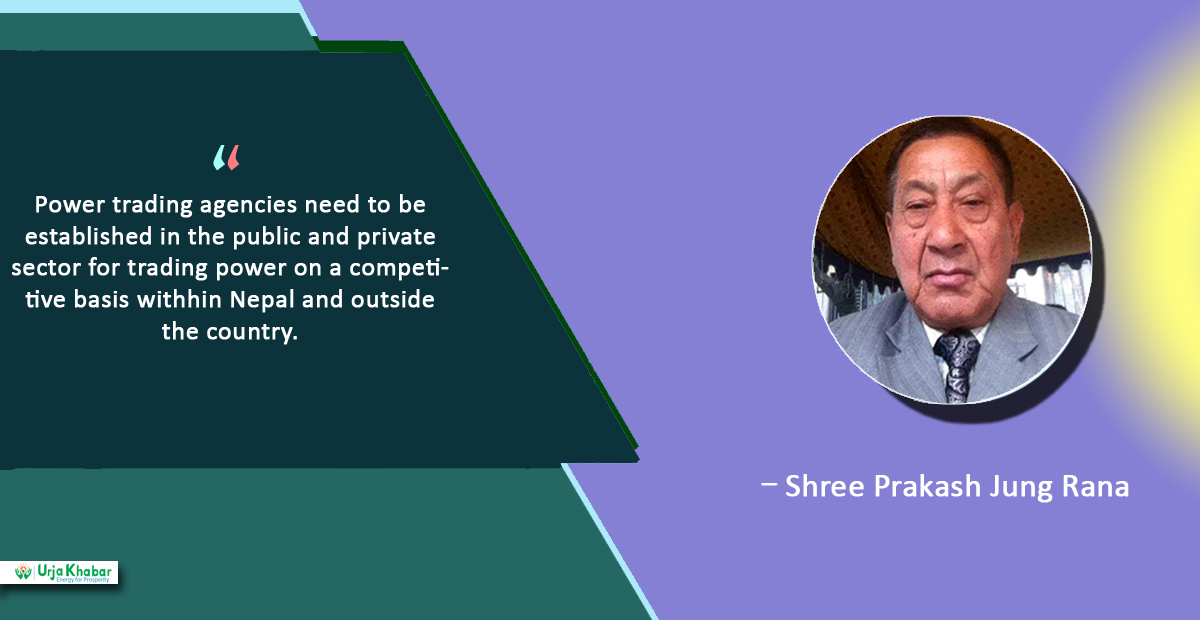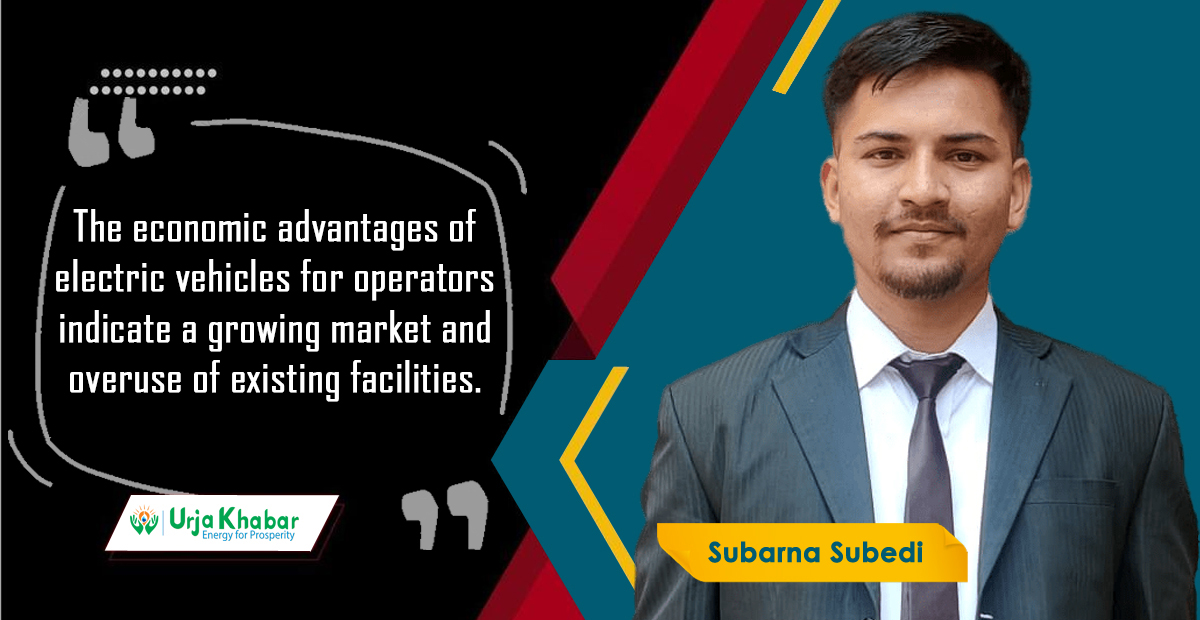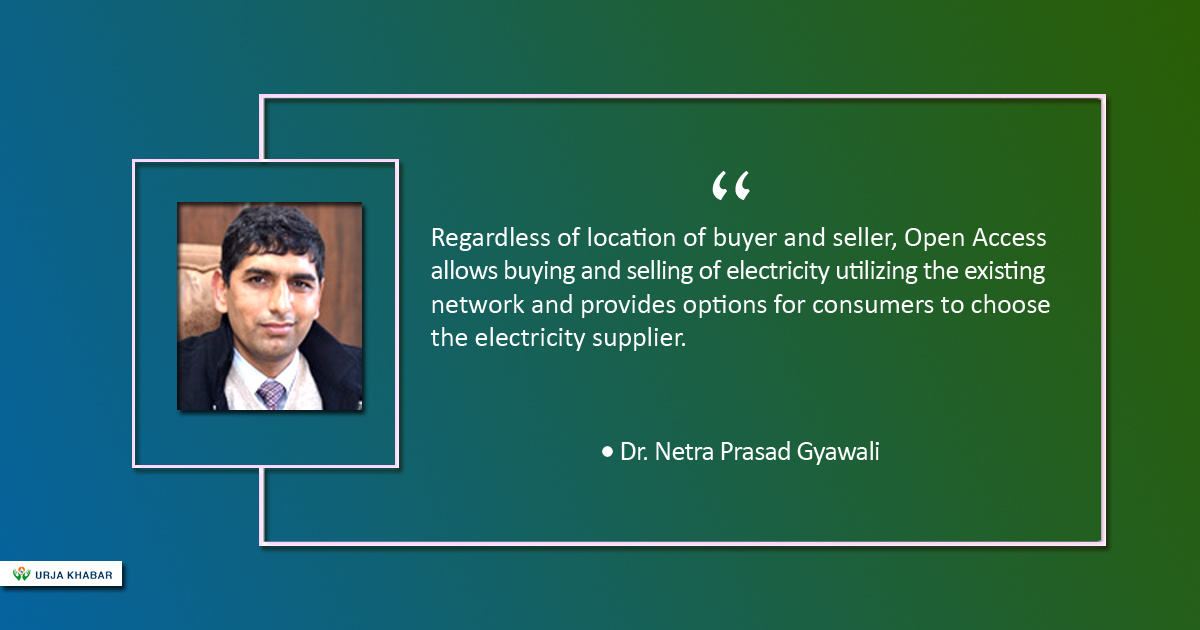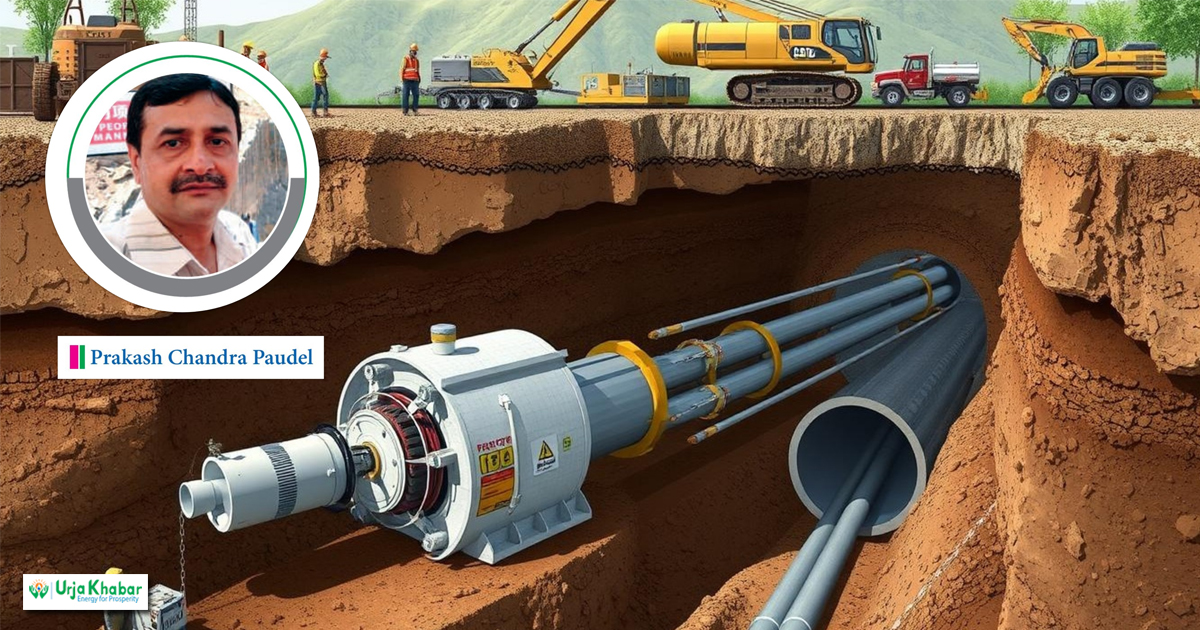Energy Update
Enhancement of Domestic Electricity Consumption and Export

1. Power Development Plan for Domestic Power Needs and Export
1.1 Key Objectives

The present key objectives of the government for the country’s power development are mainly focused upon the following issues:
a. Meeting the country’s power and energy requirements for present and future needs. (Domestic, commerce and industry, agriculture and other services).

b. Export electrical energy to neighboring countries for foreign currency earnings to minimize the nation's trade deficit.
c. Development of power resources. (Hydropower, solar, wind, and geothermal etc.)
1.2. Present Status
Nepal has the lowest per capita electricity consumption in South Asia at about 267 kWh. Till now, 92.5 percent of country’s population has access to electricity. Grid-connected versus off-grid consumers’ ratio is 96:4 percent. The system peak load of the country’s domestic power requirement in the last 2022 summer had reached 1,748 MW. However, the total power demand, including power export to India, was 1,964 MW. The central portion of the Nepalese Integrated Power System (INIPS) is managed by government-owned public sector company Nepal Electricity Authority (NEA) and shared by several Independent Power Producers (IPPs) for electricity generation.
1.3. Available Energy Resources
The installed generation capacity of INPS until the end of 2079 BS was 2,190 MW.
a. Hydro NEA 583 MW
b. Hydro NEA Subsidiary 478 MW
c. Hydro IPP 1,021 MW
d. Solar NEA 21 MW and IPP 33 MW
e. Thermal NEA 54 MW
Power Purchase Agreements (PPA) for 3,280 MW have been conducted with several IPPs, who also have been able to achieve financial closure.
a. NEA & Subsidiary hydro 447MW
b. IPP hydro 2776 MW
c. IPP solar 58 MW
Similarly, PPA for 1,553 MW has been conducted with other IPPs who have not yet achieved financial closure.
a. NEA & Subsidiary hydro 40MW
b. IPP hydro 1,504 MW
c. IPP solar 5 MW
The above figures do not include projects being constructed through bilateral agreements between India and Nepal. The total generation capacity of the Nepalese power system is to reach 7,023 MW after the completion of all PPA-signed projects (existing and under construction). Considering the present demand of the INPS at a level of 2,000 MW, a further 5,000 MW of power from upcoming projects needs to be marketed in time. The present transmission capability of INPS is also not enough to evacuate this amount of power and needs extensive augmentation before the commissioning of all the above projects. Failure in marketing the energy generated from the projects with take or pay deal with NEA in time would have a big financial impact on NEA, the government, banks, other financial institutions and shareholders as well.
2. Areas for promoting electricity consumption
2.1. Increasing per capita electricity consumption
The growth of per capita electricity consumption represents a rise in the economic status of a country. In Nepal, it has increased to 267 units (kWh) after the elimination of load shedding. Per capita electricity consumption in Nepal is much lower than in other SAARC countries (Bangladesh 319 units, Pakistan 420 units, India 707 units and Sri Lanka 531). The values for developed countries (China 3,905 units, Japan 7,820 units and USA 13,254 units) are much higher. The government aims to increase the country’s per capita electricity consumption to 700 units in the next four years' time through complete electrification all over the country. Out of the 751 local bodies of government, over 222 have achieved over 90 percent electrification. About 117 local bodies have yet to achieve a five percent electrification ratio. Growth of per capita electricity consumption depends upon reform in the economic status of the people. It depends upon growth in agriculture, productivity, industrial output, and development in the transport system, communication and mining sectors as well. A large amount of remittance received from foreign country workers also helps in raising the economic status of the country. The pace of economic development in Nepal had been very slow in the past. As such, the electricity consumption of people has not increased satisfactorily.
2.2 Promoting electricity for cooking
Even If 25 percent of existing 4.8 million electricity consumers of Nepal opt for cooking with electricity, additional 1,200 MW of electric power shall be consumed. Despite being cheaper, uses of electricity for cooking have not been substantially increased in the past years because of the following reasons:
a. The reluctance of people to switch over to other modes of cooking than LPG gas is because of many conveniences of using traditional gas stoves.
b. Fear of using electric appliances due to lack of safety knowledge in their operation.
c. Lack of confidence in the regularity of power supply during the cooking period.
Massive uses of electrical cooking appliances would highly increase power demand in LV power distribution systems, transformers and substations. Therefore, the distribution networks supplying power in homes need to be augmented to accommodate additional load arising from the use of such cooking appliances. The reliability of an uninterrupted power supply during the cooking period is essential. Traditional heaters and hot plates have to be replaced with energy-efficient induction heaters for lower power consumption and higher power factor ratio. The government must revise cheaper electricity tariffs with a substantial subsidy for motivating people to switch over to the electrical cooking option.
2.3. Electric irrigation system.
Surface irrigation system requires a high cost of investment and a longer implementation period compared to electric lift irrigation system. Electric lift irrigation systems can be implemented on an individual isolated basis at a relatively lower cost within a shorter implementation period. It also requires a separate electric distribution network for feeding power to the individual pumps. The present electricity tariff may not be affordable to the farmers for operating pumps and may require substantial subsidy by the government in making the electricity tariff cheaper. In India, the irrigation sector consumes almost 50 percent of the total electricity consumption. The government has also heavily subsidized irrigation tariffs. Uses of electricity for irrigation have a significant contribution to raising agricultural productivity and promoting electricity use on a large scale.
2.4. Electric transport system
The electric transport system is comparatively cheaper in cost compared to other traditional petroleum fuel-based systems. Petroleum fuel-based transport system needs to be replaced in phases by heavy and light electric transport systems including railways, subways, buses, cars and motorcycles, etc. The reluctance of people to switch over to electric transport system is because of the following reasons:
a. Users have less confidence in the sustainability of engine capacity
b. The need to replace batteries after a certain period needs a high cost of investment.
c. Inadequate facility of battery charging at outdoor locations.
Government should assist in the extensive promotion of electric transport systems all over the country by reducing taxes and duties on their import, production and operation. It should also establish an adequate number of battery charging stations all over the country for the convenience of the users. Implementation of an electric transport system would help in the high consumption of electricity of own country by reducing the import of petroleum fuel and decreasing the trade deficit of the country.
2.5. Electricity uses in industries
With the establishment of several industrial estates all over the country, many small and large-scale industries are expected to be established in the future. There are good prospects for agro-based industries in Nepal, producing sugar, biscuits, mustard oil and palm oil, as well as processing of food grains. Mining industries producing cement and ceramics are being established in many states. More steel manufacturing industries are being set up. Such action would demand a huge amount of electric power for their operation.
Industrialization in Nepal was not satisfactory in the past due to political instability, shortage of power and very little support from the government for this sector. A similar situation persists even now except for much reform in the availability of power. India has restricted the import of goods produced from the Nepalese industries set up with Chinese assistance. In this context, there is not much scope for exporting goods produced from such industries. Nepalese products can never compete with imported ones in terms of quality and price. At present, many industries in Nepal manufacturing steel, cement and electric vehicles are not able to run above 50 percent of their capacity because of the unavailability of an adequate market. In such circumstances, use of electrical energy in industrial sector may not be much encouraging in the near future.
2.6. Fertilizer production.
Nepal needs a huge quantity of fertilizer (Urea and DAP) to assist agricultural production every year. The government is spending a big amount of money on the import of fertilizer from other countries and provides heavy subsidies to the farmers in buying them. However, it does not work properly, blamed for late delivery to the farmers due to delays in the procurement process. The government is intending to establish a fertilizer production factory of its own within Nepal. Manufacturing fertilizer by using electricity would promote the consumption of huge quantities of the country’s own electric power. The cost of fertilizer produced from natural gas is cheaper than from electricity at the present electricity tariff. However, fertilizer production from natural gas would cause a huge amount of money outflow to India to buy natural gas. This would also aggravate the trade deficit situation of the country. The establishment of an electricity-based fertilizer factory would help in using its own electricity on a large scale. Domestic production of fertilizer from electricity could only be feasible through heavy subsidies in electricity prices. India has agreed to assist in the establishment of a fertilizer production industry in Nepal, but its modality is not known yet.
2.7. Hydrogen fuel cells
Hydrogen fuel cells work like batteries for producing electricity. Such cells can be used in homes, transportation systems, power plants and in homes for domestic appliances and laptops, etc. They also can be exported to other countries for earnings of foreign currency. Hydrogen fuel cells can be produced through thermal and electrolysis processes by using electricity as a basic raw material. A hydrogen fuel cell uses the chemical energy of hydrogen to produce electricity. Since it emits only water during its production, there are no carbon dioxide emissions in the atmosphere. Production of hydrogen fuel cells from the country’s surplus electricity generation would benefit domestic uses and also foreign currency earnings from their export. Many developed European countries are producing hydrogen fuel cells from electricity for export. Opting for such technology in Nepal would require extensive technical and financial feasibility studies in the future.
3. Power export
3.1. Prospects of Nepalese hydropower export
It is technically feasible to export Nepalese hydropower energy to most of its neighbors, like India, Bangladesh, and China, as well as Sri Lanka and Pakistan. Export of power to Sri Lanka may not be economically feasible due to the long distance and high cost of wheeling. Apart from being within a technically feasible distance for power transmission, power export to Pakistan is not practical owing to its political relations with India.
3.2. Power export to India
Nepalese hydropower energy is technically and commercially feasible for exporting to the Indian states. There is a big demand for power in India in its northern zone (especially clean energy) that can be fed from Nepalese hydropower resources by integrating and augmenting the power grid network of both countries. NEA has been exporting a significant quantum of power to India during the wet season since last year. At present, India has granted permission for around 364 MW of power export from six power stations in Nepal. However, India is reluctant to buy power from Nepalese hydropower projects developed through Chinese support in any form. There is not adequate capability in Nepalese and Indian power grid systems for evacuating huge amounts of power from several PPA-signed IPP projects commencing in the near future. India has made a bilateral agreement with Nepal to construct two hydropower projects:
a. the 1,061 MW Arun III to be developed by Sutlej, a state-owned company of India.
b. the 900 MW Upper Karnali by GMR, an Indian private company.
Both projects shall be developed on a BOT basis. Nepal is to receive 21.9 percent free energy plus royalty charges from these projects. There has been significant progress in the construction of Arun III, but the Upper Karnali project has not yet achieved financial closure. India has signed MoU for developing West Seti 750 MW and SR6 308 MW projects by the Indian public sector company NHPC in a similar modality. India has recently signed another MOU for the development of Lower Arun 669 MW project by Sutlej and the 480 MW Phuket Karnali project as well. India is totally responsible for the construction, power evacuation and marketing of power from these projects.
3.3. Power export to Bangladesh
Bangladesh with its giant 20,000 MW power system wholly depends upon its non-renewal natural gas resources for power generation. It is very much interested to buy clean renewal hydropower energy from Nepal by saving uses of its own non-renewable natural gas energy. Nepal has signed MOU with Bangladesh for selling initially 50 MW of power as a gesture through the Indian grid and India has recently shown a somewhat positive attitude toward this proposal. Bangladesh is also interested to develop a medium size hydropower project in Nepal (possibly Sunkoshi 3) for importing power from Nepal. It is planning to construct a super high voltage 745 kV transmission line through Indian territory for importing power from Nepal in the future.
3.4. Power export to China
Nepal’s northern territory borders the Tibet region of China. This region is not much industrialized yet. The present electricity demand of this region is met through hydropower resources of its own province. Major load centers of China lie beyond the Tibet region. Only a long transmission system can dispatch power to these regions. China has shown positive interest in developing cross-border power lines for power exchange. It is also interested to buy power from Nepal in the winter period. Export of Nepalese power could be feasible in Tibet with the growth of industries in that region. Nepal is investigating for construction of cross border power line connecting its power grid system with China.
4. Power development and trading strategy
4.1. Power export strategy
Nepal can be rich by selling its surplus hydropower energy to its neighboring countries. In this process, it can earn a huge amount of foreign currency through the sale of electrical energy. The government would also benefit from royalty charges, taxes and duties from the establishment of new hydropower projects. This would ultimately minimize the trade deficit, boost the economic status of the country and raise the economic standard of the people. NEA, in the past few years, exported a significant amount of hydropower energy to India in the wet season. Government should actively administer for planning, development and marketing of hydropower energy. Department of Electricity Development (DoED) should plan for exportable hydropower projects and assist in their development through public and private IPPs. Electricity Regulatory Commission (ERC) should undertake its responsibility in regulating policies and electricity tariffs for power trading within and outside the country. Public and private agencies should develop hydropower projects for domestic uses and export to other countries. NEA should be limited to the domestic electricity business of the country alone. It should sign a PPA with the IPPs only for domestic power needs. NEA should facilitate the wheeling of power to domestic and other foreign power companies through its grid network at a reasonable price. It must keep the adequate capability of the grid network for such purpose. NEA should undertake power exchange business with its grid-linked countries as well for its load requirements.
4.2. Need for strengthening power system
The present ROR-predominated power system of Nepal must be strengthened for higher annual firm generation capacity with the addition of storage, solar and pump storage hydropower projects. Storage projects should be developed with a proper share in the capacity of ROR projects for elevating the firm generation capacity of the system. Since India would also benefit from regulated water delivery from storage and PROR projects in Nepal, it should help in the development of such projects. However, Nepal must continue to develop storage projects even without Indian support. The addition of solar projects would help PROR hydropower plants to store more water in the daytime and meet peak load demand for a prolonged period in the evening. Pump storage projects would help to promote the peaking capacity of the power system by pumping more water to the reservoirs during low power demand hours and generating additional power during peak load time.
The grid network of Nepal must be augmented on a regular basis for elevating its capability for power evacuation from new hydropower projects and wheeling of power to the consumer premises as per the requirement of the power system.
4.3. Power Trading Modalities
At present, NEA is the only authorized agency executing a power trading business in Nepal. The power development plan of the government has a proposal for establishing separate autonomous power trading agencies. Power trading agencies need to be established in the public and private sectors for trading power on a competitive basis within Nepal and outside the country. Power trading companies should undertake Power Purchase Agreements with the power producers and Power Sales Agreements with large industries, electricity utility companies and cooperatives, etc. within and outside the country. Power trade companies from other countries should also be authorized to trade power businesses in Nepal. The price of electricity for the purchase and sale of electrical energy and other terms and conditions of the power trade business must be regulated through the Electricity Regulatory Commission (ERC).
A state-owned power trading company in the public sector must be established to plan and explore power trade business within and outside the country. It should execute its business on a commercial basis in coordination with the government, IPPs, and public and private utilities for the interest of public and electricity consumers.
4.4. Interstate power trading
The development of hydropower projects for power trading through bilateral agreements between the governments of two countries is another type of power trading modality. Such an option could be beneficial to both countries based on the fairness of the deal. The selling party would have the benefit of relieving in risk of construction, power evacuation and marketing. As such priority should be given to the export of power through bilateral agreements between two countries on a BOT basis. Such agreements would substantially elevate the country’s revenue collection without much risk in business. However, fairness in deals is very much important in such a business.
Mr.Rana is former DMD of Nepal Electricity Authority
This article is taken from Urja Khabar bi-annual Journal Publish on 16th June, 2023
Conversation
- Info. Dept. Reg. No. : 254/073/74
- Telephone : +977-1-5321303
- Email : [email protected]













